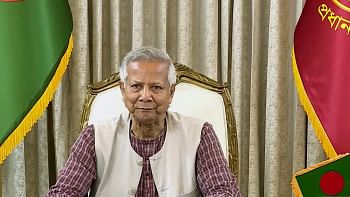Nothing clear

The Improvised Explosive Devices (IEDs) that struck the religious gathering in front of the city's Hossaini Dalan early Saturday have been used in the country by militant outfits in the past.
Operatives of banned Jama'atul Mujahideen Bangladesh (JMB) and Harkat-ul Jihad (Huji) have the expertise to make them, and the materials are available in the country. But any third party, like Islami Chhatra Shibir, too might have that expertise, investigators said.
However, it is not yet clear who were behind the attack that killed a 14-year-old boy, Sazzad Hossain, and injured at least 87 others.
Both the police chief and the Dhaka Metropolitan Police commissioner claimed that the improvised grenades used in the attack have similarities with those recovered in a drive at the capital's Kamrangirchar, following the killing of police officer Ibrahim Molla on Thursday night.
The explosions happened despite high security when people were gathering at Hossaini Dalan around 1:30am, about half an hour before the traditional Tazia procession was to be brought out to mark the holy Ashura.

'SERIOUS CONSPIRACY'
The day commemorates the martyrdom of Hazrat Imam Hussain (RA), grandson of Prophet Muhammad (pbuh). The Shia community has been observing the day for centuries in the country, with Hossaini Dalan the centre of their programmes.
Although Shia Muslims often come under attacks by the Sunni community in some countries, it is the first time that their gathering turned bloody in Bangladesh.
And unlike in many Muslim countries, there has not been any sectarian violence between these two groups in Bangladesh, where many Sunni Muslims and even non-Muslims also join the Ashura congregation in a sign of peaceful co-existence.
It is also evident in the fact that the 14-year-old boy who was killed and most of those wounded in the explosions are Sunnis. The Daily Star has learnt this by talking to their families.

Shias are minority in Bangladesh, with some 10 lakh of them living across the country, said MM Firoz Hossain, superintendent of Hossaini Dalan.
Though police detained three suspects over the blasts, they are yet to identify the attackers or learn about their motive.
Militant outfits and Shibir, Jamaat's student wing, are on top of their list of suspects, investigators said, adding that the attack was carried out to create unrest in the country ahead of November 2.
On the day, the Supreme Court is scheduled to hear arguments on the review petitions by war crimes convict Salauddin Quader Chowdhury, a top BNP leader, and Ali Ahsan Mohammad Mojaheed, a Jamaat leader. The two were earlier sentenced to death for war crimes.

Some ruling party leaders claimed that local and foreign powers might be behind the blasts to destabilise the country.
Home Minister Asaduzzaman Khan Kamal told the BBC Bangla Service last night that the attack was aimed at destabilising the country.
"The Shia community has been living here for 400 years. Nothing happened [to them] in the past. These incidents are taking place now. This points to a serious conspiracy," he said.
Police filed a case in this connection yesterday.
'FOOLPROOF SECURITY'
More than 1,500 of police members were deployed near the building and its adjoining areas to "ensure a foolproof security", said DMP Commissioner Asaduzzaman Mia.
Members of other law enforcement and intelligence agencies were also present. Uniformed and plainclothes cops were in and outside the compound. Still, the perpetrators managed to infiltrate into the premises enclosed with 20 feet high walls.
The entire area was under the surveillance of 32 CCTV cameras, owned by the building authorities. Cops were monitoring the cameras at the time.

MM Firoz said they used just four metal detectors of their own, but police did not use any such detectors or set up any metal archway at the entrances.
Police suspect the attackers took position at the nearby graveyard, just around 20 feet from the spot where two grenades went off in quick succession. The third was blasted a few feet away. Two more were found unexploded.
"We are yet to identify any attacker from the CCTV footage. It was nighttime and the footage is not clear. Also, the cameras are not that powerful," said an investigator, asking not to be named.

THE EXPLOSIVES
Each of these grenades weighed 600 grams and they were timed to go off five seconds after their pins are pulled, said Sanwar Hossain, additional deputy commissioner of Detective Branch of Police.
The casualty was low because there were no splinters or balls in the devices, added Sanwar, also head of DB's bomb disposal team.
Investigators said the technology used in making these devices is similar to that used in making the devices that went off in Burdwan of India in October last year. But their materials are "a bit different".
The Burdwan IEDs were a combination of RDX, picric acid and cycle balls. But those used in the Hossaini Dalan attack are made of gun powders, batteries and plastic explosives. In both cases, detonators and pins were used for explosion.
A senior police official with knowledge of the Burdwan blast probe and militant activities said the explosive-making technology was first brought to Bangladesh by those who took part in the Afghan war.
"Later, they transferred it to the first generation JMB operatives, including Shakil Ahmed who died in the Burdwan blast," he told The Daily Star.
He claimed several groups of Shibir activists have been working with JMB operatives to acquire this knowledge.
Col Ziaul Ahsan, additional director general of Rab, said the materials and technology used in the Ashura blasts indicate that it might be an act of militant outfits.


 For all latest news, follow The Daily Star's Google News channel.
For all latest news, follow The Daily Star's Google News channel. 



Comments